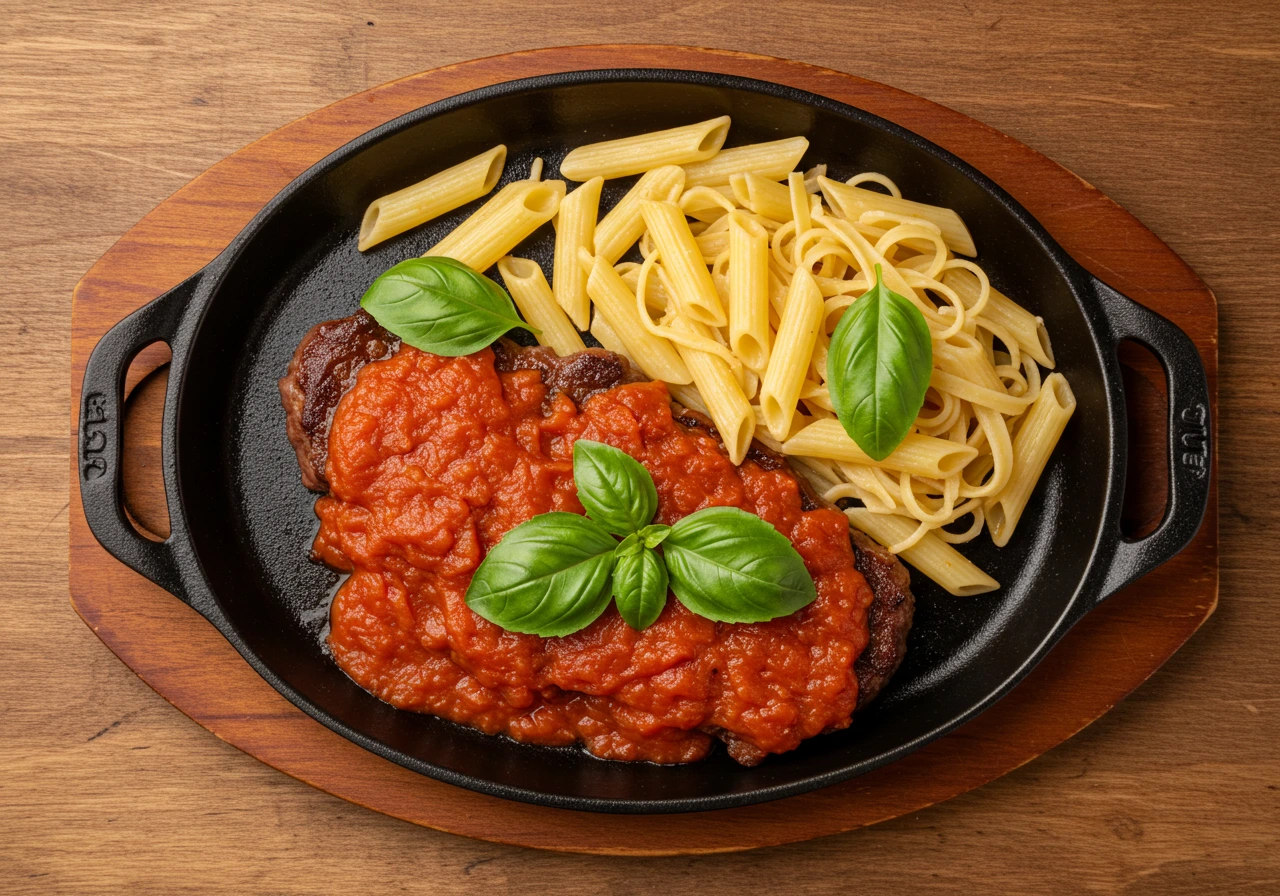Introduction: The Art of Making the Perfect Steak Pizzaiola
Steak Pizzaiola, a beloved Italian dish, is a symphony of tender steak, rich tomato sauce, and robust Mediterranean herbs. Originating from Naples, this hearty meal was designed to bring out the best flavors of simple ingredients, proving that less is often more. Over the years, variations have emerged, but the essence remains unchanged—steak simmered in a flavorful pizzaiola sauce.
In this article, we’ll guide you through every step of creating an authentic steak pizzaiola recipe, from selecting the best cut of meat to crafting the perfect sauce. Along the way, we’ll explore serving suggestions, pro tips, and even FAQs to ensure your dish turns out restaurant-quality every time.
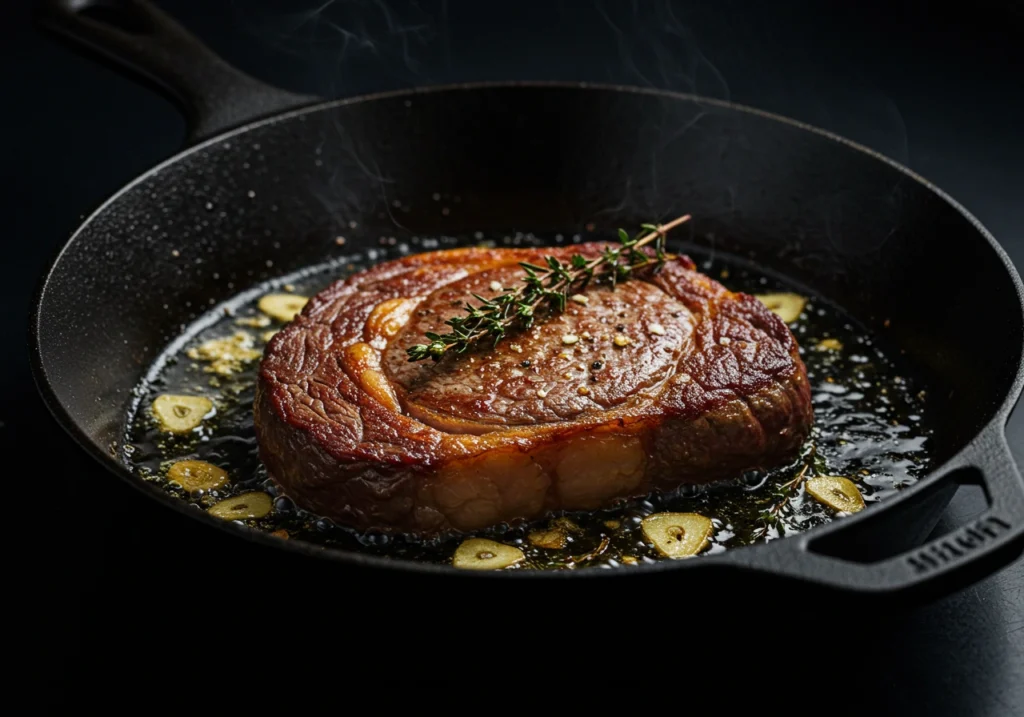
Part 1: Understanding steak pizzaiola recipe – A Flavorful Italian Classic
The story of steak pizzaiola is one of tradition, flavor, and simplicity. This dish is deeply embedded in Italian culinary heritage, and learning about its roots can help us appreciate why it has stood the test of time.
The Origins of Steak Pizzaiola
Though its exact origins are debated, carne alla pizzaiola (which translates to “meat in pizza style”) is believed to have originated in Naples, the heart of Southern Italian cuisine. It was a way for Neapolitan families to cook tougher cuts of beef slowly, allowing the flavors of garlic, oregano, and tomatoes to work their magic.
Historically, this dish was prepared with affordable, lean cuts of beef that needed extra time to become tender. The method of simmering in a fragrant tomato sauce not only softened the meat but also infused it with rich, savory flavors.
What Does “Pizzaiola” Mean?
The term pizzaiola comes from the word pizza, and it refers to the dish’s similarity to pizza sauce. Just like a pizza, steak pizzaiola incorporates tomatoes, garlic, oregano, and olive oil—a combination that captures the bold essence of traditional Italian flavors.
Why steak pizzaiola recipe is a Must-Try Dish
This dish isn’t just another steak dinner; it’s a cultural experience. Here’s why it deserves a place in your cooking repertoire:
- Authenticity: Steak Pizzaiola represents the rustic charm of Italian home cooking.
- Easy to Make: With minimal ingredients and simple cooking techniques, it’s a beginner-friendly dish.
- Rich & Bold Flavors: The slow simmering process allows the steak to soak up all the rich flavors.
- Versatility: You can customize it by adding bell peppers, capers, or mushrooms.
The Evolution of Steak Pizzaiola
Over the years, different regions in Italy have put their own spin on the dish. While the classic Neapolitan version sticks to a simple tomato and herb sauce, other variations incorporate:
- Peppers and onions for extra sweetness.
- Spicy red pepper flakes for a bolder kick.
- Cheese-topped variations, including mozzarella, to mimic a pizza-like texture.
How steak pizzaiola recipe Became a Global Favorite
Italian immigrants introduced this dish to the United States, where it quickly became a staple in Italian-American cuisine. Today, you’ll find it served in homes and restaurants worldwide, often paired with pasta, rice, or crusty bread.
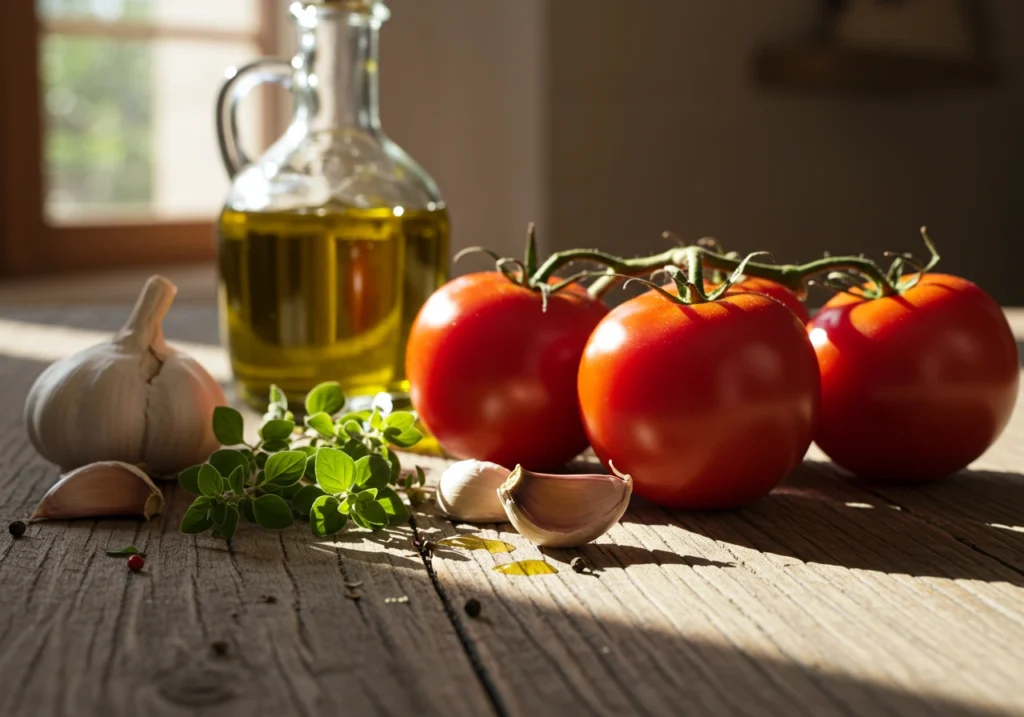
My First Time Trying steak pizzaiola recipe
The first time I cooked steak pizzaiola, I didn’t expect such an explosion of flavor from just a handful of ingredients. The aromatic scent of garlic and oregano filled my kitchen, and as the steak simmered, the sauce transformed into a thick, velvety coating around the meat. When I took my first bite, it was tender, juicy, and bursting with a balance of tangy and savory notes. From that moment on, it became a go-to comfort meal in my home.
Part 2: Ingredients and Their Roles
The magic of steak pizzaiola lies in its simplicity, yet every ingredient plays a crucial role in delivering rich, bold flavors. Selecting the right cut of beef and combining it with quality ingredients ensures that the dish reaches its full potential.
Selecting the Right Cut of Beef
When it comes to choosing beef for steak pizzaiola, selecting the right cut is essential. The ideal steak should be flavorful, tender, and able to hold up to slow simmering without becoming tough.
Recommended Cuts
For the best results, go for cuts that strike a balance between tenderness and marbling. These cuts allow the meat to absorb the flavors of the sauce while remaining juicy.
- Sirloin: A popular choice due to its moderate marbling and tender texture.
- Ribeye: Known for its rich marbling, ribeye delivers buttery tenderness and deep flavor.
- Chuck Steak: Slightly tougher than sirloin or ribeye, but when simmered slowly, it becomes incredibly tender and flavorful.
I personally prefer ribeye for steak pizzaiola, as it remains juicy even after simmering in tomato sauce.
Alternative Options
For a budget-friendly version, you can opt for leaner cuts, which still produce delicious results when cooked correctly.
- Flank Steak: While leaner, flank steak benefits from tenderizing techniques, such as slicing against the grain.
- Round Steak: This is one of the tougher cuts, but low and slow cooking allows it to become tender.
If you choose a leaner cut, consider pounding it slightly with a meat mallet to ensure a more tender bite.
Tomatoes: The Heart of the Sauce
A great pizzaiola sauce starts with high-quality tomatoes, which provide the dish’s signature tangy and rich base.
Fresh vs. Canned Tomatoes
Both fresh and canned tomatoes work well for steak pizzaiola, but the choice depends on seasonality and availability.
- Fresh Tomatoes: When in season, vine-ripened tomatoes bring a natural sweetness and bright acidity to the sauce.
- Canned San Marzano Tomatoes: These are a top choice for convenience, offering consistent flavor and rich texture, making them ideal when fresh tomatoes aren’t available.
Personally, I love using San Marzano tomatoes because they have a naturally sweet taste and low acidity, which enhances the sauce without needing added sugar.
Preparation Techniques
For the smoothest sauce, take the time to prepare your tomatoes properly.
- For Fresh Tomatoes:
- Blanch them in boiling water for about 30 seconds.
- Peel off the skin once cooled.
- Remove seeds to reduce bitterness.
- Chop or blend to achieve the desired consistency.
- For Canned Tomatoes:
- Crush them by hand or blend them lightly for a smoother consistency.
Whether using fresh or canned tomatoes, the key to a great sauce is slow simmering, which marries the flavors beautifully.
Aromatics and Herbs
The depth of steak pizzaiola comes from the aromatics and herbs that infuse the sauce with layers of complexity.
Garlic and Onions
These two ingredients are the backbone of pizzaiola sauce, providing savory depth and a slight sweetness.
- Garlic: Fresh minced garlic adds a robust punch to the sauce.
- Onions: Diced yellow or white onions contribute a mild sweetness that balances the acidity of the tomatoes.
For the best flavor, sauté garlic and onions in olive oil before adding the tomatoes—this unlocks their natural sweetness and reduces bitterness.
Oregano and Basil
Herbs elevate the pizzaiola sauce from good to great by enhancing its earthy and fresh notes.
- Dried Oregano: This is the traditional choice for a pizzaiola-style sauce, giving it a distinct Mediterranean flavor.
- Fresh Oregano or Basil: Adds bright herbal freshness—basil, in particular, gives the sauce a slightly sweet undertone.
I always add dried oregano while cooking and toss in fresh basil at the end for maximum aroma.
Additional Flavor Enhancers
To level up your steak pizzaiola, consider incorporating extra ingredients that add texture, complexity, and depth.
Peppers and Mushrooms
Adding bell peppers and mushrooms takes steak pizzaiola recipe to another level.
- Bell Peppers: Provide natural sweetness and a slight crunch.
- Mushrooms: Soak up the sauce beautifully, adding a meaty, umami-rich taste.
Sautéing these before adding them to the sauce helps bring out their natural sweetness.
Olives for a Mediterranean Touch
For those who enjoy a briny kick, olives add a hint of saltiness that balances the rich tomato base.
- Kalamata or Black Olives: These add a pop of acidity and complement the tomatoes beautifully.
Part 3: Step-by-Step Cooking Guide
Now that we have the perfect ingredients, it’s time to bring them to life! Cooking steak pizzaiola involves a few essential steps: prepping the beef, searing it to perfection, crafting a rich sauce, and slow-cooking everything together. Each stage builds flavor, ensuring a tender, juicy steak bathed in a vibrant tomato sauce.
Preparing the Beef
The first step in making steak pizzaiola recipe is to prepare the beef properly. This ensures the meat cooks evenly and absorbs the delicious sauce.
Trimming and Seasoning
Before cooking, it’s important to trim any excess fat from the steak. While some fat adds flavor, too much can result in a greasy sauce.
- Place the steak on a cutting board and use a sharp knife to trim any large pieces of excess fat.
- Season generously with:
- Salt: Enhances the natural beefy flavor.
- Black pepper: Adds a mild spice and depth.
- (Optional) Red pepper flakes: For a touch of heat.
Seasoning the steak before cooking locks in flavor and helps create a beautiful crust when seared.
Pounding for Tenderness
To ensure even cooking and optimal tenderness, gently pound the steak.
- Place the steak between two sheets of parchment paper or plastic wrap.
- Use a meat mallet (or rolling pin) to gently pound the meat to an even thickness (about ½ inch thick).
- Avoid over-pounding, as the steak should remain intact but tenderized.
Pounding helps break down tough muscle fibers, making the meat juicier and more succulent when cooked.
Searing the Beef
A proper sear locks in the steak’s juices and builds layers of flavor before it simmers in the sauce.
Achieving a Proper Sear
For a golden-brown crust, follow these steps:
- Heat a large skillet or cast iron pan over medium-high heat.
- Add olive oil (about 2 tablespoons) and let it heat until shimmering.
- Carefully place the steak in the pan, allowing it to cook undisturbed for 2-3 minutes per side.
- Flip the steak and cook the other side for another 2-3 minutes.
- Remove the steak when a deep golden crust forms.
This Maillard reaction (the browning process) intensifies the meat’s natural flavors.
Setting Aside
Once seared, transfer the steak to a plate or baking dish and let it rest. This allows the juices to redistribute, preventing dryness when simmered.
Crafting the Sauce
Now comes the soul of steak pizzaiola—its robust, tomato-based sauce. This step is where the flavors meld together, creating that classic pizzaiola taste.
Sauteing Aromatics
Using the same pan (without cleaning it!), build the base of the sauce:
- Lower the heat to medium and add 2 tablespoons of olive oil.
- Add 4 cloves of minced garlic and 1 diced onion, stirring frequently.
- Cook for about 3-4 minutes, until the onions are soft and translucent.
The leftover steak bits in the pan will infuse the sauce with rich, meaty flavor.
Deglazing and Simmering
Once the aromatics are fragrant:
- Deglaze the pan by adding ½ cup of broth (or water), scraping up the brown bits from the pan.
- Stir in:
- 1 can (28 oz) of crushed San Marzano tomatoes.
- 1 teaspoon dried oregano (or 1 tablespoon fresh oregano).
- ½ teaspoon red pepper flakes (optional, for a spicy kick).
- Salt and black pepper, to taste.
- Simmer uncovered for 10-15 minutes, allowing the sauce to thicken and develop its rich flavor.
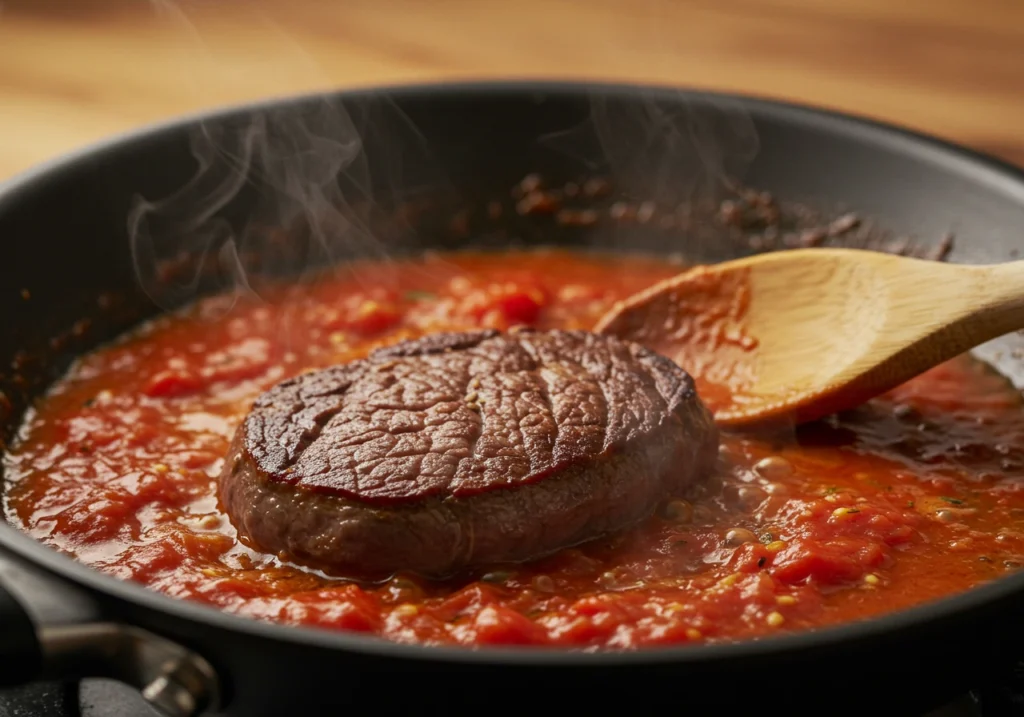
At this point, your kitchen will be filled with the incredible aroma of simmering tomatoes, garlic, and herbs.
Combining Beef and Sauce
Now it’s time to marry the flavors by braising the beef in the sauce.
Braising to Perfection
- Return the seared steak to the skillet, nestling it into the sauce.
- Lower the heat to a gentle simmer and cover the pan.
- Let it braise for 25-30 minutes, occasionally spooning the sauce over the steak.
As it simmers, the steak will absorb the rich tomato flavors, making every bite incredibly tender and flavorful.
Adjusting Seasonings
Before serving, taste the sauce and make final adjustments:
- More salt? If the sauce needs more balance.
- A dash of olive oil? For added richness.
- Fresh basil? To brighten up the dish.
Part 4: Serving Suggestions
A beautifully cooked steak pizzaiola deserves an equally delicious pairing. The right side dish can enhance the flavors of the tender, sauce-infused beef, making it a complete and satisfying meal. Whether you prefer a traditional Italian experience or a modern twist, there are plenty of ways to enjoy this dish.
Traditional Accompaniments
For those who love the authentic flavors of Italy, these classic pairings will complement the savory tomato sauce and tender steak perfectly.
Pasta: A Classic Choice
One of the most common ways to serve steak pizzaiola is over a bed of pasta. The rich tomato sauce clings beautifully to the pasta, creating a well-balanced dish.
Best Pasta Choices:
- Spaghetti: The long, thin strands soak up the sauce, making every bite flavorful.
- Linguine: A slightly flatter pasta that works well with the hearty sauce.
- Pappardelle: Wide, ribbon-like noodles that pair wonderfully with the tender beef.
- Rigatoni: If you prefer a short pasta, rigatoni’s ridges help hold onto the sauce.
To serve, toss the pasta with a little olive oil, then ladle the steak and sauce on top. Garnish with fresh basil and grated Parmesan cheese for an authentic Italian touch.
Crusty Italian Bread: The Perfect Companion
Sometimes, simplicity is best. A loaf of crusty Italian bread is a fantastic way to soak up every last bit of the delicious pizzaiola sauce.
Best Bread Choices:
- Ciabatta: Light, airy, and perfect for dipping.
- Baguette: Its crisp crust and soft interior make it a great complement.
- Focaccia: Adds a slightly herbaceous touch that enhances the dish.
For an extra burst of flavor, try grilling the bread with a drizzle of olive oil and a sprinkle of garlic powder.
Modern Twists
If you’re looking for a new take on this classic dish, these contemporary pairings add a unique and delicious twist.
Creamy Polenta: A Velvety Base
If you want a gluten-free alternative to pasta, creamy polenta makes an excellent choice. Its smooth, buttery texture pairs beautifully with the robust tomato sauce, creating a comforting, melt-in-your-mouth experience.
How to Make It:
- In a saucepan, bring 4 cups of broth (or water) to a simmer.
- Slowly whisk in 1 cup of cornmeal (polenta) while stirring continuously.
- Reduce the heat and cook for 10-15 minutes, stirring occasionally.
- Finish with 2 tablespoons of butter and ½ cup of grated Parmesan for extra creaminess.
Spoon the pizzaiola sauce and steak over the warm polenta and enjoy a luxuriously smooth and hearty meal.
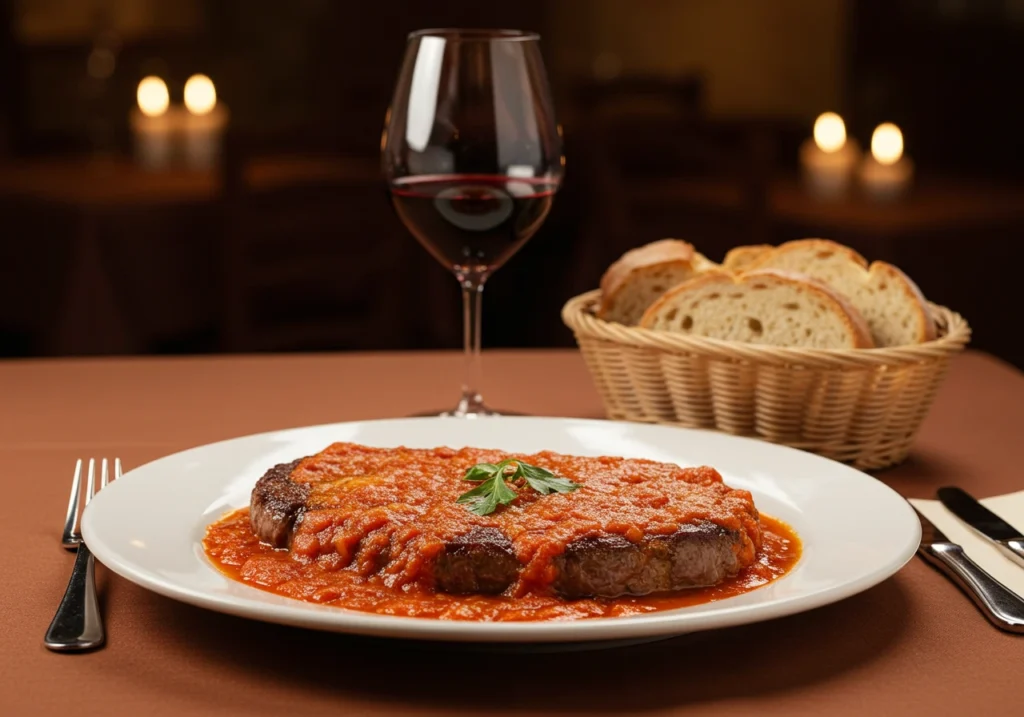
Roasted Vegetable Medley: A Healthier Option
For a lighter take on steak pizzaiola, a side of roasted vegetables provides a nutritious and colorful contrast to the dish.
Best Vegetables to Roast:
- Zucchini – Adds a mild sweetness that balances the acidity of the sauce.
- Bell Peppers – Enhances the dish with vibrant color and a slight crunch.
- Eggplant – Absorbs flavors beautifully and offers a rich, earthy note.
- Asparagus – Brings a slight bitterness that complements the sauce.
How to Roast:
- Preheat the oven to 400°F (200°C).
- Toss the vegetables with olive oil, salt, pepper, and a pinch of oregano.
- Spread them out on a baking sheet and roast for 20-25 minutes, or until caramelized.
The slightly charred edges of the roasted veggies add depth and texture, making them an excellent pairing with the saucy steak.
Part 5: Frequently Asked Questions (FAQs)
Cooking steak pizzaiola often brings up a few questions about its origins, pairings, and variations. Here are some of the most common ones!
What does pizzaiola mean in Italian?
The word pizzaiola comes from the Italian term alla pizzaiola, which means “in the style of the pizza maker.” It refers to the dish’s sauce, which shares similar ingredients with traditional pizza sauce, including tomatoes, garlic, oregano, and olive oil.
What wine complements steak pizzaiola recipe?
A full-bodied red wine pairs beautifully with steak pizzaiola because it complements the rich tomato sauce and enhances the meaty flavors. Some great choices include:
- Chianti – A classic Italian wine with bright acidity to balance the tomato’s tanginess.
- Sangiovese – Offers earthy and fruity notes that pair well with the steak.
- Zinfandel – A bolder option with hints of pepper and spice.
What to serve with chicken pizzaiola?
If you’re making chicken pizzaiola, consider these sides:
- Pasta – Traditional and perfect for soaking up the sauce.
- Mashed Potatoes – A creamy contrast to the savory tomato sauce.
- Steamed Greens – Such as spinach or kale, for a fresh and healthy pairing.
What is the origin of steak pizzaiola recipe?
Steak pizzaiola originated in Naples, Italy, where cooks developed the dish as a way to make tougher cuts of beef tender and flavorful using slow cooking in a tomato-based sauce. It has since become a staple in Italian-American cuisine.

